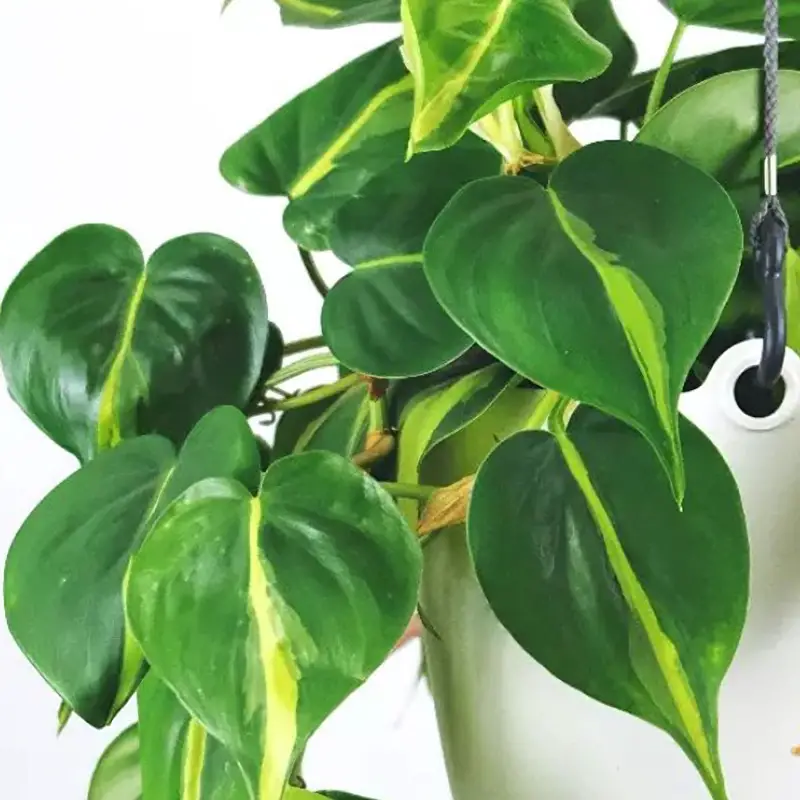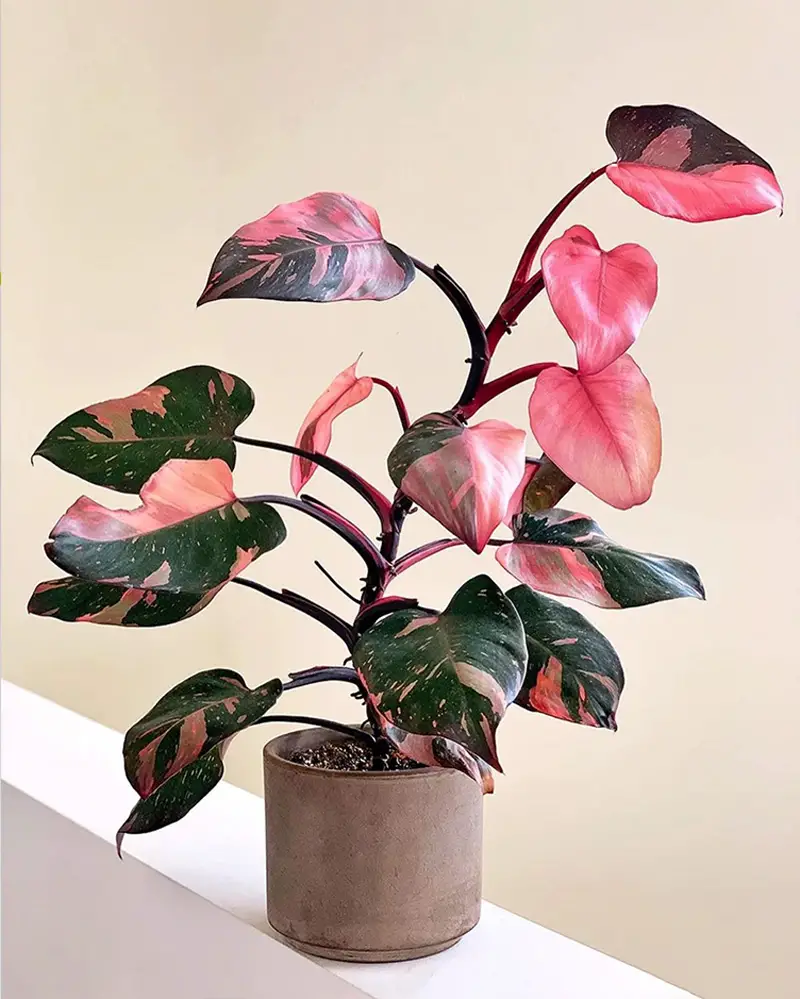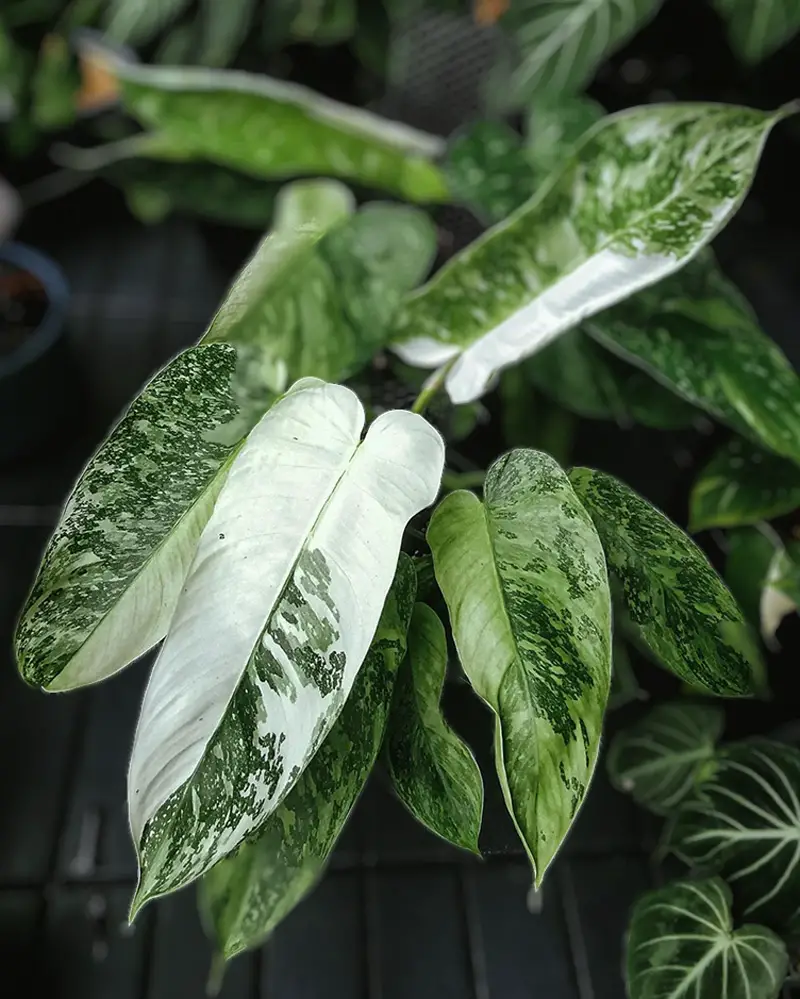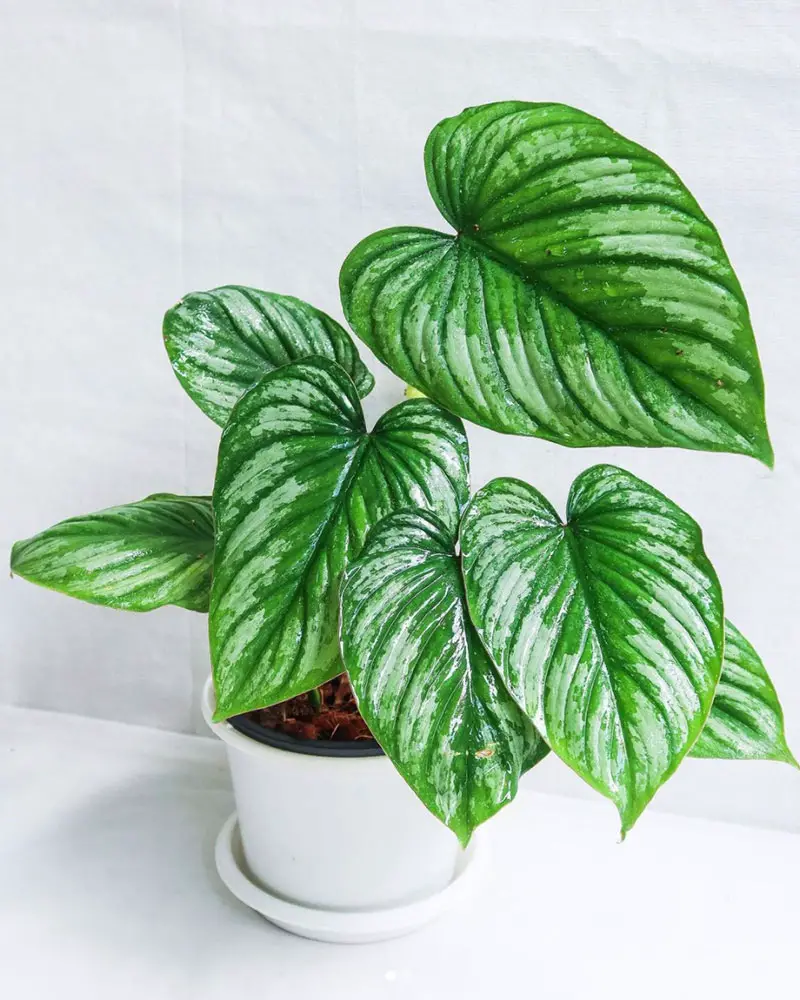
Philodendrons continue to grow in popularity over time. As I browse online, there are always new types of Philodendron I hadn’t seen before.
In fact, there are approximately 480 varieties of philodendron in the world, varying in size, color, texture, and growth habits. Philodendrons are popular pot plants due to their low maintenance requirements while offering stunning displays of delicate leaves and flowers.
In this article, I will show you the 25 most popular Philodendron varieties ranked according to their rarity:
Let’s get started!
Common Philodendron
Here are some common philodendron varieties available with information to help you identify and take care of them.
Ring of Fire
One of the most beautiful Philodendron varieties is the Ring of Fire, named by a nursery called Asiatica. This variety is a hybrid developed by Keith Henderson and known as Henderson’s Pride.

The Ring of Fire got its name because the leaves develop in several colors, including cream, orange, red, pink, and green, making them look like flames. This plant is very sought after and propagated by tissue culture.
This philodendron variety is a slow-growing one that can reach about eight feet (2.43 m) when fully grown, with the leaves easily reaching about two feet (0.60 m) in length. The plant likes moist soil that drains well and is rich in organic matter, with a pH of 6-6.5.
It prefers bright indirect light. Lower light conditions will inhibit color development, but direct sunlight can cause sunburnt leaves. Humidity levels should be moderate.
Black Cardinal
Black Cardinal isn’t a climbing or sprawling plant. Instead, it’s a self-heading plant.

This plant is also known as the Red-leaf Philodendron for its dark burgundy-red leaves and deep red stems. It gets its name because the leaves are so red that they appear almost black with the oldest leaves being the darkest. Younger leaves tend to have a lighter, almost coppery color.
This plant is easy to grow, requiring similar care to all Philodendron varieties. It likes rich, well-drained soil that’s moist at all times. However, it doesn’t thrive in Alkaline potting mixes. It likes medium light but can grow in slightly lower light conditions.
Burle Marx
Among all the Philodendron varieties, the Burle Marx is the easiest to propagate. This plant is named after Burle Marx, an accomplished Brazilian landscape artist who was among the first to start using native plants in landscape design.

This plant is characterized by its narrow heart-shaped leaves and reddish stems. It’s commonly mistaken for another Philodendron variety known as the Billietiae Philodendron. However, the Burle Marx has textured leaves and grows to only about two feet (0.60 m) tall.
In its native habitat – the tropical forests of Brazil – the Burle Marx grows in low clumps and prefers partial or dappled sunlight.
It doesn’t need any special care beyond what you would normally ensure for any Philodendron – moist but well-draining soil and a regular watering schedule. However, Burle Marx does prefer partial or full shade when it comes to lighting conditions instead of the bright indirect light preferred by the other Philodendron varieties.
Micans
Micans is among the Philodendron varieties with heart-shaped leaves. It looks very similar to the Heartleaf Philodendron, but the leaves have reddish undersides and a velvety texture. Micans is also known as Velvet Leaf Philodendron for this texture. It is frequently mistaken for the Heartleaf Philodendron, however, the Heartleaf has leaves that are glossy instead of velvety.

Micans are trailing plants and do well when kept in hanging pots that allow the plant to extend downwards.
Like other Philodendron varieties, the Micans prefer to be potted in a well-draining potting mix rich in organic matter. 100% sphagnum peat moss, peat vermiculite, or peat perlite are all good options for potting mix. The pots should be placed in a location with bright, indirect light like next to an east-facing window with a sheet curtain.
Philodendron Brasil
Philodendron Brasil is a variegated version of the popular Heartleaf Philodendron varieties developed and patented by Ruben Ernesto Acosta of Holambra, Brazil.

This plant is among the most common Philodendron varieties and is distinguished by the band of yellow found on most of its heart-shaped leaves.
Caring for Philodendron Brasil is fairly easy and the same as other Philodendron varieties. The plant doesn’t need fertilizers as long as the potting mix has organic matter mixed in. It grows best in bright indirect light but can grow in partial or full shade. However, it may lose its variegation if it doesn’t receive sufficient sunlight, especially since it’s a developed variety.
Prince of Orange
Prince of Orange is among the many hybrid Philodendron varieties popular among plant collectors for its bright coloration. New leaves of the Prince of Orange are bright orange, which changes to green as the leaf grows and matures.

This variety will grow about 24-36 inches (60-90cm) tall, and like the other Philodendrons, it’s a perennial plant that can survive as long as temperatures don’t go below 50 degrees Fahrenheit.
The Prince of Orange prefers bright indirect light like all other Philodendron varieties but is fine even in partial or full shade. The bright orange color of the new leaves is unaffected by the lighting conditions. However, the leaves may grow smaller if the plant doesn’t receive enough sunlight.
Philodendron Xanadu
The Philodendron Xanadu is among the bushing Philodendron varieties, which grows about 2-4 feet (0.60-1.21 m) tall and spreads out about 8-12 inches (20-30cm) wide. The leaves are a deep green, narrow, and serrated, and the foliage on this Philodendron is usually very thickly packed.

The Xanadu likes to be warm and prefers high levels of humidity and its leaves do well with regular misting.
The plant must be placed in areas that receive medium to bright indirect sunlight, in soil rich with organic matter. It should be watered regularly to keep the soil moist but not soggy.
Philodendron Bipinnatifidum
The Philodendron Bipinnatifidum is a tropical plant that grows best in full sun but can adapt to partial or full shade. It’s among the varieties of Philodendron reclassified under the genus Thaumatophyllum and is also known by the names Split-Leaf Philodendron and Tree Philodendron.

The Philodendron Bipinnatifidum is frequently confused with the Monstera Deliciosa, especially when the plants are young. This confusion is caused by the distinct splits in the leaves, giving them a lobed appearance. While the Monstera also develops fenestrations or holes in its leaves, the Philodendron Bipinnatifidum only has deep splits or lobes.
The plant does well when placed in a well-draining, moist potting mix rich in organic matter, though it won’t grow as tall as it does in its native tropical jungles. It grows like a regular plant, with a woody stem and smooth, drooping petioles that hold the leaves. It won’t tolerate any salt build-up in the soil, so it must be watered carefully.
The care of a Philodendron Bipinnatifidum is the same as the other Philodendron varieties; the plant prefers a warm, humid environment to grow in, with plenty of indirect sunlight.
Philodendron Hope Selloum
The Philodendron Hope Selloum is a different name for the Philodendron Bipinnatifidum, which was reclassified as Thaumatophyllum bipinnatifidum in 2018. It’s also known as the Split-Leaf Philodendron or the Tree Philodendron. Another name for this variety is the Lacy Tree Philodendron.
Philodendron Lemon Lime
The Philodendron Lemon Lime is easily identified by its vibrant lemon-green leaves. The color is vivid enough to be considered neon.

Because of its neon green leaves, the Philodendron Lemon Lime is frequently confused with the Neon Pothos since both plants have light neon green leaves. The primary difference is that the Philodendron Lemon Lime has more texture on its leaves and grows thinner aerial roots.
It’s also confused with the Moonlight Philodendron, which has neon leaves. However, the Philodendron Lemon Lime has heart-shaped leaves, unlike the more oblong-shaped leaves of the Moonlight variety.
This Philodendron is a trailing variety that grows well in hanging pots in bright indirect sunlight. The care for the Lemon Lime is the same as the other philodendron varieties – regular watering of soil rich in organic matter that drains well in a warm, humid environment. Ensure that the potting mix is neutral or slightly acidic to mimic the natural growing conditions of the Philodendron.
Rare Philodendron
Next, I’ll discuss some rare Philodendron varieties that are harder to find than the more common varieties we just discussed.
Pink Princess (Philodendron Erubescens)
The Pink Princess is a hybrid Philodendron distinguished by the pink variegation on its leaves. It’s also known as the blushing Philodendron for its beautiful pink variegation mixed in with the dark green of the leaves and its red stems.

This plant is a climbing vine that needs to be supported with a trellis or a pole. It must be kept in bright indirect sunlight because insufficient light will reduce the variegation in the plant and cause leggy growth in the plant. However, you should avoid the harsh afternoon sun.
The best kind of sunlight for the Pink Princess is morning sunlight from dawn till about noon.
The rarity of the Pink Princess is due to the difficulty in reproducing the variegation in propagated plants, even when the mother plant has a lot of pink variegation. Once grown, the plant is hardy and grows well and requires the same care as any other Philodendron.
Philodendron White Knight
The White Knight is another hybrid Philodendron with variegation. This plant is known for the bright white variegation on the leaves, which usually presents as banding, but sometimes an entire leaf may grow white.

The White Knight is a climbing plant frequently confused with the very similar Philodendron White Wizard, which is also a climbing hybrid Philodendron with white Variegations. The White Knight is smaller than the White Wizard, and its variegations are smaller than those on the White Wizard.
While the main aspects of care for the White Knight remain the same as other Philodendron varieties, light conditions must be carefully maintained for the White Knight. Anything less than filtered, bright indirect light will result in the leaves losing their variegation.
However, the white parts of the White Knight’s leaves are very susceptible to sunburn, so the plant should never be exposed to harsh, bright light, especially afternoon light.
Philodendron Jose Buono
The Jose Buono is a climbing variety of Philodendrons with large lime green spade-shaped leaves. The plant is rare and in high demand because of the stable cream to white variegation on its leaves that occur naturally.

The variegation appears as banding and splashes on the leaves and deepens over time, but the leaves don’t lose their variegation easily, unlike the hybrid Philodendron varieties.
Philodendron Jose Buono can climb up to 12 feet (3.65 m) or more when planted in the ground but tends to grow smaller in pots. Like all Philodendrons, it prefers neutral to acidic soil, with high organic matter and low salt content. The soil should be kept moist, with a watering schedule that lets the excess runoff and the majority of the soil wetness evaporate in between waterings.
Since the variegation on the Philodendron Jose Buono is stable, it doesn’t need to be placed in an area with bright light. The plant does well in partial or dappled shade and in bright indirect light.
Philodendron Birkin
The Philodendron Birkin is a hybrid variegated variety of Philodendrons that developed due to a chimeric mutation of Philodendron Rojo Congo.

This plant has unusual variegation where the dark green leaves have cream to white patterns along the veins. This variegation is unstable, so the plant may revert to its original green over time, without warning or cause.
The Philodendron Birkin is frequently confused with the Round Leaf Calathea, which has similarly deep green leaves with silver stripes. But it’s easily differentiated from the Birkin by the rounded shape of its leaves.
Another lookalike is the Zebra plant, but the Zebra plant’s leaves are a darker green, and the white variegation is thicker than in the Birkin.
The Philodendron Birkin needs the same environmental and soil conditions as the other Philodendron varieties. While most Philodendrons prefer bright, indirect light, this plant can be grown in partial shade as well.
Florida Beauty
The Florida Beauty is a variegated hybrid of the Philodendron Pedatum, a plant with lobed leaves that are very distinctive. Each leaf typically has about five distinct lobes. The leaves are bright green, with variegation that can be cream to white, yellow, or pink.

The Florida Beauty is frequently mixed up with the Florida Ghost, which is a variety of Philodendron that also has white variegation. But in the Florida Ghost, the variegation might encompass the entire leaf. Additionally, the Florida Beauty has red petioles, which are very textured, unlike the smooth green petioles of the Florida Ghost.
Caring for Florida Beauty is not different from other Philodendron varieties. Like the other variegated hybrids, the Florida Beauty is sensitive to slight variations and must be kept in bright indirect sunlight to maintain its variegation.
Painted Lady
The Painted Lady is known for its unusual foliage, where the light green spade-shaped leaves have yellow mottling scattered throughout, radiating from the yellow stem line running through the center of the lead. This, contrasted with the bright pinkish-red petioles, makes for a very striking climbing plant.

The Painted Lady can be confused for the Philodendron Moonlight. However, the Moonlight has evenly neon green leaves, without the mottling that’s distinctive to the Painted Lady. Another similar variety is the Rising Sun, but this variety has smoother leaves and plain petioles, unlike the Painted Lady.
This Philodendron variety doesn’t need any care beyond the standard care for Philodendrons except for sunlight. The Painted Lady has stable variegation, so it can be grown in partial to full shade.
Philodendron Mamei
The Philodendron Mamei has large green heart-shaped leaves which are semi-glossy with a reddish base. The leaves may have silvery markings on the leaves, which look like smudges along the edges of the leaves, leading to the central vein. It’s also known as the Silver Cloud or the Quilted Silver Leaf plant.

This plant is a perennial creeper that grows well in conditions suited to all Philodendron varieties. It can grow in partial shade as well as bright indirect sunlight.
Philodendron Moonlight
The Philodendron Moonlight is known for its smooth neon green spade-shaped leaves with red petioles.

It’s a hybrid variety frequently confused with the Philodendron Painted Lady, which has neon mottling, or the Philodendron Lemon Lime, which has heart-shaped leaves.
The leaves on the Philodendron Moonlight start as yellow that deepen to light green as the leaf grows and matures. This plant is easy to grow and has the same care requirements as other Philodendron varieties.
Philodendron Gloriosum
The Philodendron Gloriosum is a creeping vine with large heart-shaped leaves. The plant is distinctive for its white, cream, or pinkish veins with pink margins on velvety dark green leaves.

Because of the venation, the Philodendron Gloriosum resembles the Philodendron Birkin. However, the Birkin’s veins are finer and appear white or cream, not pink. The variegations also don’t have the pink margins and velvety texture of the Gloriosum.
This plant is rare because of habitat decline, and it’s classified as vulnerable by the IUCN.
The Philodendron Gloriosum needs the same care as the other Philodendron varieties.
Very Rare Philodendron
Now, here is a collection of some very rare cultivars of Philodendron.
Philodendron Silver Sword
The Philodendron Silver Sword is the common name of the Philodendron Hastatum, a plant known for its sharp leaves shaped like a sword’s blade. It’s also named for the distinctive, silvery sheen on the leaves, especially the juvenile ones.

It’s a rare and endangered vine despite being fairly easy to care for. The destruction of its natural habitat has led to the Silver Sword’s endangered status.
The Silver Sword is easy to care for with the same conditions as every other variety of Philodendron.
Philodendron Bloody Mary
The Philodendron Bloody Mary is known for its deep red petioles that lead into narrow heart-shaped dark green, almost burgundy leaves. But the plant derives its name from the fact that the new leaves start with a blood-red coloration before maturing to a burgundy green.

This Philodendron is a climbing variety that needs the support of a trellis or a pole so it can climb upwards. The growth tends to be drooping, so you shouldn’t worry about the leaves if they look a bit listless.
Like all Philodendron varieties, the Bloody Mary needs moist but not soggy soil rich in organic matter. The plant should be placed in bright indirect sunlight and moderate humidity.
Philodendron Melanochrysum
Philodendron Melanochrysum is also known as the black-gold Philodendron for its dark, velvety green leaves with yellow veins. The plant might be confused with the Philodendron Gloriosum, but the Gloriosum’s veins have pink margins.

The Melanochrysum is a rare climbing Philodendron variety. The juvenile leaves are coppery red, but they mature into the characteristic dark green leaves with yellow veins that give it the name of black-gold.
While the care for this plant is the same as all other Philodendron varieties, it has a greater susceptibility to red spider mites and scale insects.
To prevent pest attacks, check the leaves regularly and use natural fungicides like neem oil concentrate to remove any eggs. Also ensure that the soil is not soggy as wet conditions encourage larval growth.
Philodendron Plowmanii
The Philodendron Plowmanii is a creeping vine with large heart-shaped leaves with ruffled edges. The leaf is highly textured with veins.

The plant, named botanist Timothy Plowman, is one of the rarest Philodendron varieties due to its habitat destruction and slow-growing nature.
This plant should ideally be grown outside, and while it can adapt to different lighting conditions except for bright direct light, it shouldn’t be grown in areas where the temperature goes below 30 °F (-1.11°C).
The soil, watering, and temperature requirements of the Philodendron Plowmanii are the same as the other Philodendron varieties.
Extremely Rare Philodendron
Last but not least, here is some information on one of the rarest Philodendron varieties.
Philodendron Spiritus Sancti
The Philodendron Spiritus Sancti is extremely rare because it’s an endangered plant in its native Brazil and is poached heavily.

The plant is known for its narrow pendant-shaped leaves that can grow as large as 30 inches in length. This climbing vine also has red petioles, contrasting beautifully with its dark green leaves.
This variety of Philodendrons is easy to grow but difficult to propagate, which is why it’s all the rarer. Caring for the Spiritus Sancti involves the same care that all Philodendron varieties need.
Also read:
• 10 Most Popular Monstera Varieties: Complete Guide (Pictures & Cost)
• 11 Most Popular Calathea Varieties: Complete Guide (Pictures & Cost)
